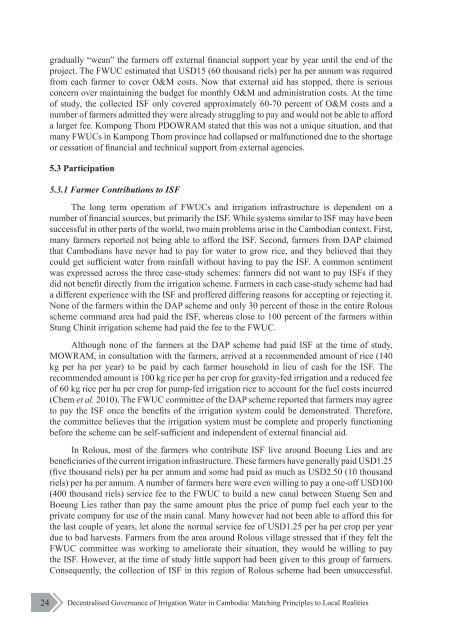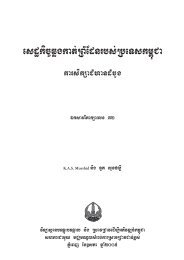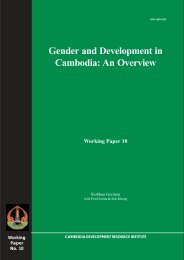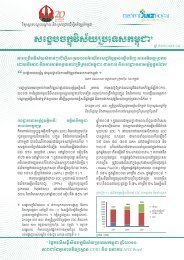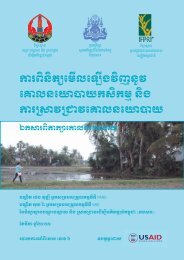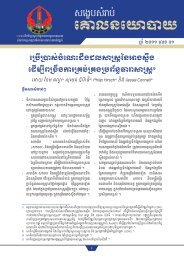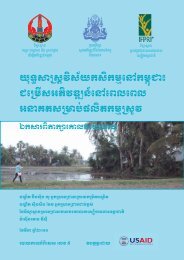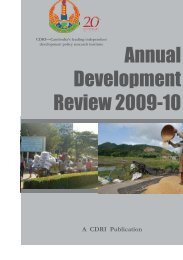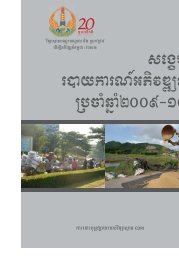62) decentralised governance of irrigation water in cambodia - CDRI
62) decentralised governance of irrigation water in cambodia - CDRI
62) decentralised governance of irrigation water in cambodia - CDRI
Create successful ePaper yourself
Turn your PDF publications into a flip-book with our unique Google optimized e-Paper software.
gradually “wean” the farmers <strong>of</strong>f external f<strong>in</strong>ancial support year by year until the end <strong>of</strong> the<br />
project. The FWUC estimated that USD15 (60 thousand riels) per ha per annum was required<br />
from each farmer to cover O&M costs. Now that external aid has stopped, there is serious<br />
concern over ma<strong>in</strong>ta<strong>in</strong><strong>in</strong>g the budget for monthly O&M and adm<strong>in</strong>istration costs. At the time<br />
<strong>of</strong> study, the collected ISF only covered approximately 60-70 percent <strong>of</strong> O&M costs and a<br />
number <strong>of</strong> farmers admitted they were already struggl<strong>in</strong>g to pay and would not be able to afford<br />
a larger fee. Kompong Thom PDOWRAM stated that this was not a unique situation, and that<br />
many FWUCs <strong>in</strong> Kampong Thom prov<strong>in</strong>ce had collapsed or malfunctioned due to the shortage<br />
or cessation <strong>of</strong> f<strong>in</strong>ancial and technical support from external agencies.<br />
5.3 Participation<br />
5.3.1 Farmer Contributions to ISF<br />
The long term operation <strong>of</strong> FWUCs and <strong>irrigation</strong> <strong>in</strong>frastructure is dependent on a<br />
number <strong>of</strong> f<strong>in</strong>ancial sources, but primarily the ISF. While systems similar to ISF may have been<br />
successful <strong>in</strong> other parts <strong>of</strong> the world, two ma<strong>in</strong> problems arise <strong>in</strong> the Cambodian context. First,<br />
many farmers reported not be<strong>in</strong>g able to afford the ISF. Second, farmers from DAP claimed<br />
that Cambodians have never had to pay for <strong>water</strong> to grow rice, and they believed that they<br />
could get sufficient <strong>water</strong> from ra<strong>in</strong>fall without hav<strong>in</strong>g to pay the ISF. A common sentiment<br />
was expressed across the three case-study schemes: farmers did not want to pay ISFs if they<br />
did not benefit directly from the <strong>irrigation</strong> scheme. Farmers <strong>in</strong> each case-study scheme had had<br />
a different experience with the ISF and pr<strong>of</strong>fered differ<strong>in</strong>g reasons for accept<strong>in</strong>g or reject<strong>in</strong>g it.<br />
None <strong>of</strong> the farmers with<strong>in</strong> the DAP scheme and only 30 percent <strong>of</strong> those <strong>in</strong> the entire Rolous<br />
scheme command area had paid the ISF, whereas close to 100 percent <strong>of</strong> the farmers with<strong>in</strong><br />
Stung Ch<strong>in</strong>it <strong>irrigation</strong> scheme had paid the fee to the FWUC.<br />
Although none <strong>of</strong> the farmers at the DAP scheme had paid ISF at the time <strong>of</strong> study,<br />
MOWRAM, <strong>in</strong> consultation with the farmers, arrived at a recommended amount <strong>of</strong> rice (140<br />
kg per ha per year) to be paid by each farmer household <strong>in</strong> lieu <strong>of</strong> cash for the ISF. The<br />
recommended amount is 100 kg rice per ha per crop for gravity-fed <strong>irrigation</strong> and a reduced fee<br />
<strong>of</strong> 60 kg rice per ha per crop for pump-fed <strong>irrigation</strong> rice to account for the fuel costs <strong>in</strong>curred<br />
(Chem et al. 2010). The FWUC committee <strong>of</strong> the DAP scheme reported that farmers may agree<br />
to pay the ISF once the benefits <strong>of</strong> the <strong>irrigation</strong> system could be demonstrated. Therefore,<br />
the committee believes that the <strong>irrigation</strong> system must be complete and properly function<strong>in</strong>g<br />
before the scheme can be self-sufficient and <strong>in</strong>dependent <strong>of</strong> external f<strong>in</strong>ancial aid.<br />
In Rolous, most <strong>of</strong> the farmers who contribute ISF live around Boeung Lies and are<br />
beneficiaries <strong>of</strong> the current <strong>irrigation</strong> <strong>in</strong>frastructure. These farmers have generally paid USD1.25<br />
(five thousand riels) per ha per annum and some had paid as much as USD2.50 (10 thousand<br />
riels) per ha per annum. A number <strong>of</strong> farmers here were even will<strong>in</strong>g to pay a one-<strong>of</strong>f USD100<br />
(400 thousand riels) service fee to the FWUC to build a new canal between Stueng Sen and<br />
Boeung Lies rather than pay the same amount plus the price <strong>of</strong> pump fuel each year to the<br />
private company for use <strong>of</strong> the ma<strong>in</strong> canal. Many however had not been able to afford this for<br />
the last couple <strong>of</strong> years, let alone the normal service fee <strong>of</strong> USD1.25 per ha per crop per year<br />
due to bad harvests. Farmers from the area around Rolous village stressed that if they felt the<br />
FWUC committee was work<strong>in</strong>g to ameliorate their situation, they would be will<strong>in</strong>g to pay<br />
the ISF. However, at the time <strong>of</strong> study little support had been given to this group <strong>of</strong> farmers.<br />
Consequently, the collection <strong>of</strong> ISF <strong>in</strong> this region <strong>of</strong> Rolous scheme had been unsuccessful.<br />
24 Decentralised Governance <strong>of</strong> Irrigation Water <strong>in</strong> Cambodia: Match<strong>in</strong>g Pr<strong>in</strong>ciples to Local Realities


